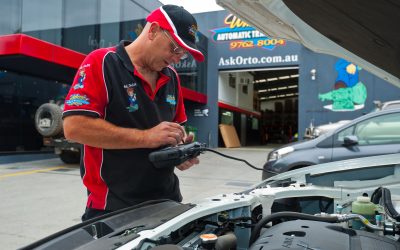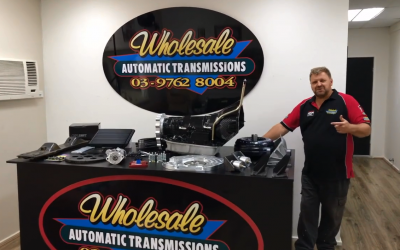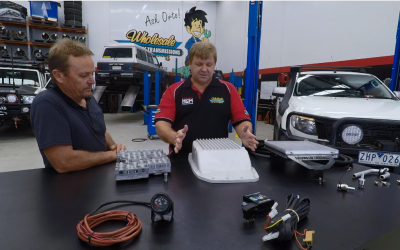
About the Author
Rodney "Rocket Rod" is one of the Directors of Wholesale Automatics. He has been in the automatic transmission industry for over 30 years. Rodney mainly focuses on Marketing and New Projects and is the driving force behind creating new ways to bolt different parts together for our conversion projects. Rodney is also responsible for the majority of the entertainment at Wholesale Automatics.
Check out our installation video below for the Hilux 6 Speed. Many other models will also have an install video available as well as online fitting instructions.
At Wholesale Automatics we stock a wide range of vehicle specific nomad valve body products. These include:
Ford
Everest 6 Speed
Ranger 6 Speed (Vehicle Build Before June 2014)
Ranger 6 Speed (Vehicle Build After June 2014)
Isuzu
D-MAX 4 Speed
D-MAX 5 Speed
MU-X 5 Speed
D-MAX 6 Speed
MU-X 6 Speed
Lexus
LX 570 6 Speed
Mazda
BT50 TF 6 Speed
BT50 6 Speed (Vehicle Build Before June 2014)
BT50 6 Speed (Vehicle Build After June 2014)
Mitsubishi
Challenger 5 Speed
Pajero 5 Speed NM, NP, NS
Pajero 5 Speed NT, NW, NX
Triton 4 Speed
Triton MN 5 Speed
Triton MQ 5 Speed
Triton MR 6 Speed
Nissan
Navara 4 Speed
Navara D40 5 Speed
Pathfinder 5 Speed
Patrol GQ and GU 4 Speed
Patrol GU 5 Speed
Toyota
FJ Cruiser 5 Speed
Fortuner 6 Speed
Hilux 1KZ 4 Speed
Hilux 4 Speed
Hilux 5 Speed
Hilux 6 Speed
LandCruiser 60 4 Speed
LandCruiser 80 3FE Hydraulic 4 Speed with Cruise Control
LandCruiser 80 1HD-T Hydraulic 4 Speed with Cruise Control
LandCruiser 80 3FE Hydraulic 4 Speed without Cruise Control
LandCruiser 80 1HD-T Hydraulic 4 Speed without Cruise Control
LandCruiser 80 Series Electronic 4 Speed (4 Solenoid)
LandCruiser 100 4 Speed (5 Solenoid)
LandCruiser 100 5 Speed
LandCruiser 105 4 Speed (4 Solenoid)
LandCruiser 200 5 Speed
LandCruiser 200 6 Speed
Prado 90 4 Speed
Prado 120 4 Speed
Prado 120 5 Speed
Prado 150 5 Speed
Prado 150 6 Speed
Tundra 6 Speed
For most nomad valve body products you will be able to see a DIY Installation Video as well as access online written fitting instructions. Find your nomad valve body product on the website and then click on the Installation Video or Fitting Instructions tab for additional information.
An example of Installation Video and Fitting Instructions is below for the Nomad Heavy Duty Valve Body to suit Toyota Hilux 6 Speed
You can also access all of the resources for the Valve Bodies under the Technical Support Menu. To have a look at this menu click here.
Check out our official Nomad Valve Body page.
FAQ
What is a Valve Body?
Also known as a transmission valve body, it is a maze of channels with lots of valves and springs. The valves are controlled via hydraulics or via electronics (in late model vehicles). Each of the valves will either prevent oil from flowing, enable it to start flowing or vary the pressure at which it can flow. When a valve is opened the oil can apply pressure to a clutch or route the oil to another valve. By combining a series of valve opens/closes, the transmission can engage or disengage certain clutches which in turn can shift gears, engage the torque converter lockup, or neutralise. This means that one set of valves on the valve body might give you 1st gear, while another set of valves might engage reverse.
By re-calibrating the flow of this oil through the use of modified valves, separating plates and springs, we can affect how clutches apply, provide better lubrication, increase longevity and even increase the flow to the coolers.
Why do I need a Valve Body?
People looking at buying a Nomad Valve Body are regularly wanting outcomes like:
- A big upgrade in their capability to tow caravans, horse floats and boats.
- Firmer, cleaner shifts.
- Any OEM faults completely removed.
- Overcome transmission flaring after installation of performance upgrades. Ie Tuning, Chips, Exhausts etc.
- Greatly reduced wear and tear on clutch packs inside the automatic transmission that lead to excessive repair costs earlier than expected.
- Allows any lock-up kit to work in 1st gear for true 100% engine braking on demand.
- Minimises hunting.
- Reduces sluggish, slow gear changes on both up and down shifts including kick down.
- Improves engine responsiveness.
- Upgrades the transmission’s natural ability to provide engine braking by 10-15%.
- Improves fuel economy.
- Decreases transmission temperature. By raising the transmission’s torque converter pressure, this changes the viscosity of the transmission oil within the torque converter. The side effect of this is greater engine braking, fuel economy and less heat generation.
What happens when a valve body goes bad?
One of the most common symptoms of a failing transmission valve body is harsh shifting, flares between gears, flaring on shifting and inconsistent gear changes. Please note that many of these same symptoms can also be within the transmission and may not be a problem with the valve body. It would be best to seek 1:1 help with a specialised transmission repair shop. Our experience is that we commonly see faults with the Ford Ranger / Mazda BT50 6R80 valve bodies and VW Amarok valve bodies. It is far less common in the Toyota range and Holden Colorado. However we do see a lot of requests to upgrade valve bodies to a higher capacity allowing for the transmission to be more capable both on an offroad.
Can you drive with a bad valve body?
When you experience a symptoms of a bad transmission valve body it is generally very noticeable. Most likely you won’t be able to let it go for too long as it will greatly impact your driving ability and frustrate you while trying to change gears. More importantly you probably shouldn’t drive the car at all with such symptoms as it could cause more damage to the transmission.
How much does it cost to replace a valve body?
A quality Nomad Valve Body from Wholesale Automatics costs typically between $1,295 and $1,595. These can be fitted as a DIY or professionally fitted for around $600.
Can a valve body be repaired?
Rebuilding a valve body is a great option that is typically less expensive than purchasing an installing a brand new one. Most valve bodies at Wholesale Automatics are sold on an exchange basis where you send in your old valve body provided it is not too damaged.
Does a transmission rebuild include the valve body?
A transmission rebuild will typically include upgrading the valve body. This will, of course, depend on the individual needs of the rebuild and whether the valve body was already upgraded prior to the rebuild.
Can you clean a valve body?
A valve body will require cleaning if there is a build-up of carbon deposits or metallic/non metallic debris inside it causing the valves to stick. The valve body needs to be dismantled and cleaned with a solvent.
Other Posts
Servicing Your Automatic Transmission
Regular servicing of your automatic transmission is essential for optimal performance and safety. Don’t be fooled by some common servicing myths.
Conversion Kit to suit Nissan GQ or GU Patrol 6BT Cummins to 4L80E Automatic
See the conversion kit put together for a customer. We also discuss some of the different upgrade and conversion options offered by Wholesale Automatics.
Ford Ranger Upgrades
See the range of upgrades available at Wholesale Automatics for your Ford Ranger. Improve the performance and durability of your transmission and maximise fuel efficiency.




